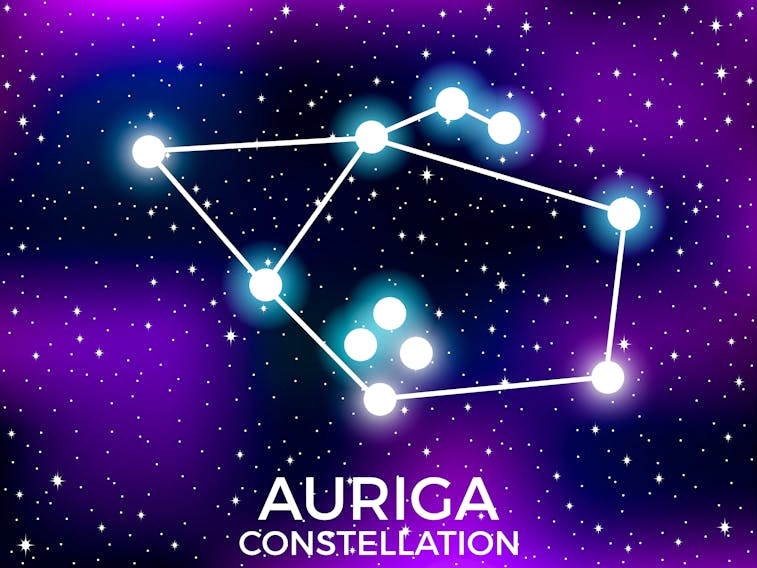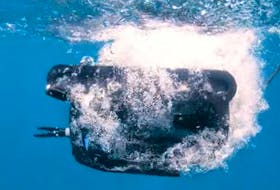As with many Greek (and Roman) myths, many different versions find their way into Greece’s literary (both written and oral) history and culture. Ultimately, regardless of the version, many of the individuals involved, both mortal and immortal, were represented by the constellations visible in the night sky. It was no different with that of the constellation of Auriga (Latin for “charioteer”).

Erichthonius, an ancient king of Athens, was reputed to be autochthonous (“born of the earth”) as the result of a rather dishonourable attempt by Hephaestus (Greek god of blacksmithing, metallurgy and volcanoes) to have his way with Athena (Greek goddess of wisdom, handicrafts and warfare). When he sprang from the earth, Athena took Erichthonius under her protection. Since she was also the protectress of the city of Athens, Erichthonius, in time, became its ruler. It is said that he taught his subjects how to smelt silver, use the plough to till the earth, and how to yoke horses and train them to pull chariots. It is claimed that he was responsible for the quadriga — the four-horse chariot (think Ben-Hur movie chariot race); he was said to have been an avid and excellent chariot racer. Zeus honoured him by placing him in the heavens upon his demise.
Other Greek myths say this constellation represents either Myrtilus, the son of Hermes (winged messenger of the gods), who was the charioteer of King Oenomaus, King of Pisa in southern Greece, or Bellerophon, a mortal Greek hero who dared ride Pegasus (the winged-horse of Greek mythology) up to Mount Olympus.
Whomever it represents, Auriga is a prominent winter constellation, visible in the night sky above the constellations of Orion — the Hunter and Taurus — the Bull. It’s brightest star — Capella — is one of five bright stars that form the asterism of the Winter Hexagon; the other five stars being Rigel (in Orion), Aldebaran (in Taurus), Pollux (in Gemini), Procyon (in Canis Minor) and Sirius (in Canis Major). Capella is associated with the myth of the she-goat Amalthea, who is said to have suckled the infant Zeus. It is perhaps this myth that led to Capella being denoted as the she-goat, and two stars of a three-star asterism to its south as her young ones — the Haedi — (the Kids) on star charts.
As with last week, Venus is visible at dusk above the SW horizon. It sets around 7:30 p.m., nearly three hours after the Sun. Mars is visible in the SE, rising in the pre-dawn sky shortly before 5 a.m., and remaining visible until about 7 a.m. Mercury, Jupiter and Saturn are all too close to the Sun, and are not presently visible.
I forgot to mention (it actually slipped my mind) last week that Earth is actually closer (by roughly five million kms.) to the Sun in January than in July. Earth’s actual perihelion (closest approach to the Sun) was yesterday, Jan. 5, 2020.
The reason we don’t have warmer weather at this time of the year, despite being closer to the Sun, has to do with the northern hemisphere’s tilt away from the Sun at this time, which spreads the Sun’s radiation out over the Earth’s northern land masses at a shallower angle.
This, plus the factor of less daylight hours, and, correspondingly, less sunlight to warm the northern hemisphere’s atmosphere, results in our colder weather. The southern hemisphere, both closer to and tilted towards the Sun at this time of the year, is enjoying a warmer summer.
The native peoples of eastern North America called January’s full moon “the wolf moon”, after the howling wolves that roamed through the surrounding forests at this time of year.
Until next time, clear skies.
Glenn K. Roberts lives in Stratford, P.E.I., and has been an avid amateur astronomer since he was a small child. His column, Atlantic Skies, appears each week. He welcomes comments from readers, and anyone who would like to do so is encouraged to email him at [email protected].
Events:
Jan. 10 - Full (Wolf) Moon
More ATLANTIC SKIES
Taurus charges across the night sky









